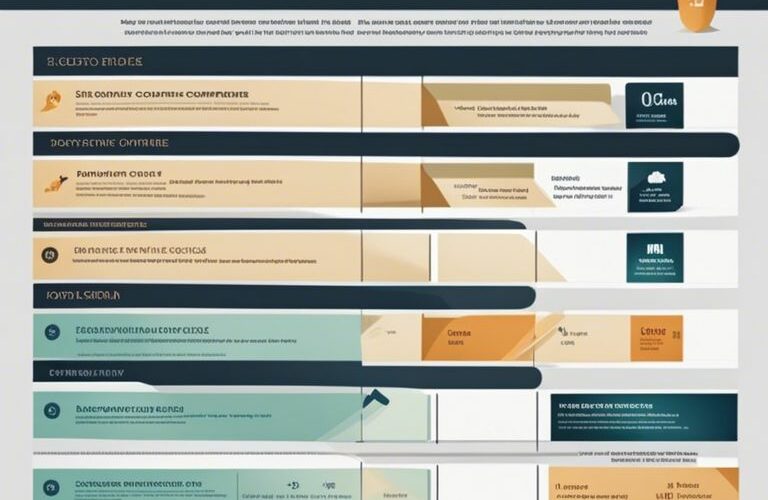Many e-commerce businesses overlook the critical importance of mapping out the customer journey. Understanding how customers interact with your online store from the moment they land on your website to the point of making a purchase is crucial for optimizing the user experience and driving sales. By carefully analyzing and designing the customer journey, businesses can increase conversions, improve customer satisfaction, and build long-lasting relationships with their audience.
Mapping the e-commerce customer journey involves identifying all touchpoints and steps that a customer goes through while interacting with the online store. From the initial awareness stage to the post-purchase experience, every interaction plays a significant role in shaping the customer’s perception of the brand. By mapping out these touchpoints, businesses can pinpoint areas for improvement, optimize the user experience, and tailor their marketing strategies to better meet the needs and expectations of their customers.
Without a clear understanding of the e-commerce customer journey, businesses risk losing potential sales, frustrating customers, and missing out on valuable insights. By mapping out the customer journey, e-commerce companies can enhance their overall performance, increase customer loyalty, and stay ahead of the competition in today’s digital marketplace.
Defining the E-commerce Customer Journey
For e-commerce businesses, understanding the customer journey is crucial in delivering a seamless shopping experience. The e-commerce customer journey encompasses the entire process from the moment a consumer first hears about a product or service to the point of making a purchase and beyond. By mapping out the customer journey, businesses can identify key touchpoints and potential areas for improvement to enhance the overall shopping experience.
The Stages of the Customer Journey
Ecommerce customer journey typically consists of several stages, starting with awareness, followed by consideration, decision, and finally, the purchase. During the awareness stage, customers become aware of a product or service through various channels such as social media, online ads, or word-of-mouth. In the consideration stage, they research and compare different options before moving on to the decision stage where they choose to make a purchase. The final stage is the purchase, where customers complete the transaction and potentially become repeat customers.
Understanding the customer journey’s stages is necessary for e-commerce businesses to tailor their marketing strategies and communications to meet customers’ needs at each point. By optimizing the shopping experience at every stage, businesses can increase customer satisfaction, loyalty, and ultimately boost sales.
The Evolution of Online Shopping Behavior
Journeying through the evolution of online shopping behavior sheds light on how consumer habits and preferences have changed over time. With the rise of mobile devices and the convenience of online shopping, customers now expect a seamless and personalized experience. The evolution of online shopping behavior highlights the importance of businesses adapting to new technologies and trends to meet customer expectations and stay ahead of the competition.
Understanding the evolution of online shopping behavior is crucial for e-commerce businesses to stay relevant and competitive in today’s market. By embracing new technologies, personalizing the shopping experience, and offering convenience, businesses can attract and retain customers in the ever-changing online retail landscape.
The Role of Data in Mapping the Customer Journey
Collecting the Right Data
Right data collection is the foundation for accurately mapping the e-commerce customer journey. It is important to gather relevant information at every touchpoint to understand how customers interact with your online store. This includes tracking website visits, email open rates, purchases, returns, and more. By focusing on the right data points, you can uncover valuable insights into customer behavior and preferences.
Utilizing tools such as Google Analytics, CRM systems, and heat maps can help e-commerce businesses capture the right data efficiently. These tools provide in-depth analysis of customer activities, allowing companies to tailor their marketing strategies and improve the overall shopping experience. By leveraging the power of data analytics, businesses can make informed decisions to enhance customer interactions and drive sales.
Moreover, implementing data privacy measures is crucial in today’s digital landscape. By ensuring compliance with regulations such as GDPR, businesses build trust with customers and safeguard their information. By collecting the right data ethically and securely, e-commerce businesses can create a personalized customer journey that leads to long-term loyalty and satisfaction.
Analyzing Customer Interactions
Right analysis of customer interactions is key to understanding the effectiveness of your e-commerce strategies. By examining customer behaviors and preferences, businesses can identify patterns and trends that influence purchasing decisions. Through thorough analysis of data collected at various touchpoints, companies can optimize their marketing efforts and tailor product offerings to meet customer needs.
Understanding the customer journey from initial engagement to final purchase is vital in creating a seamless shopping experience. By analyzing data on browsing habits, cart abandonment rates, and feedback received, e-commerce businesses can refine their processes and enhance customer satisfaction. This allows companies to address pain points proactively and deliver a personalized approach that resonates with their target audience.
Understanding how customers interact with your online store provides valuable insights that drive business growth. By continuously monitoring and analyzing customer interactions, e-commerce businesses can adapt their strategies to meet evolving market demands. This proactive approach ensures that companies stay ahead of the competition and build lasting relationships with their customers.
Customer Touchpoints in E-commerce
Despite the many digital channels available to e-commerce businesses today, understanding the customer touchpoints across various platforms is imperative for a successful online strategy. Customer touchpoints are those critical moments when a potential customer interacts with your brand, whether it’s through social media, your website, email, or even a physical store. Mapping out these touchpoints helps identify where customers are coming from, what they are looking for, and how they are engaging with your brand.
Identifying Key Touchpoints
Customer touchpoints can vary greatly depending on your business and target audience. It is crucial to identify the key touchpoints that have the most impact on your customers’ decision-making process. These touchpoints could include social media interactions, website visits, product searches, email communications, and customer reviews. By understanding these touchpoints, you can tailor your marketing efforts to meet the needs and preferences of your customers at each stage of their journey.
One way to identify key touchpoints is by analyzing data from various sources, such as website analytics, social media insights, and customer feedback. By tracking the customer’s journey from the first point of contact to the final purchase, you can gain valuable insights into where customers are dropping off or experiencing friction. This information is crucial for optimizing touchpoints and improving overall conversion rates.
By optimizing key touchpoints, businesses can create a seamless and personalized shopping experience for customers, leading to increased engagement and higher conversion rates. This process involves making sure that each touchpoint is optimized for usability, relevance, and consistency across channels. By focusing on the most critical touchpoints, businesses can drive customer loyalty and repeat purchases, ultimately leading to long-term success.
Optimizing Touchpoints for Engagement and Conversion
Optimizing touchpoints for engagement and conversion is a continuous process that requires monitoring and testing different strategies to see what resonates best with your customers. By analyzing data and customer feedback, businesses can make informed decisions on how to improve each touchpoint for maximum impact. This could involve A/B testing different call-to-action buttons, optimizing website navigation for a smoother shopping experience, or personalizing email campaigns based on customer behavior.
To create a truly effective e-commerce customer journey, businesses must prioritize key touchpoints and continuously optimize them to meet the evolving needs of their customers. By focusing on providing a seamless and personalized experience across all channels, businesses can build brand loyalty and drive conversions. Keep in mind, a well-thought-out customer touchpoint strategy can make all the difference in today’s competitive e-commerce landscape.
Creating Customer Personas and Journey Maps
The Process of Developing Customer Personas
To truly understand your e-commerce customers, you must develop detailed customer personas. This involves conducting thorough research on your target audience to create fictional characters that represent different customer segments. The process starts by gathering data on demographics, behavior patterns, interests, and pain points. By analyzing this information, you can create personas that embody the characteristics of your actual customers. These personas provide a clear picture of who your customers are and what they need, enabling you to tailor your e-commerce strategy accordingly.
Once you have developed your customer personas, it is necessary to ensure they are accurate and realistic. This may involve conducting surveys, interviews, or using analytics tools to gather feedback from existing customers. By continuously refining and updating your personas based on new insights, you can ensure they remain relevant and representative of your target audience. Customer personas serve as a guiding light in your e-commerce strategy, helping you make informed decisions that resonate with your customers.
Customer personas are invaluable assets that shape every aspect of your e-commerce business, from product development to marketing strategies. By understanding the various needs, preferences, and behaviors of your customers through detailed personas, you can create personalized experiences that drive customer engagement and loyalty. Investing time and resources in developing accurate customer personas is crucial for e-commerce businesses looking to establish strong connections with their target audience.
Constructing Comprehensive Journey Maps
On the journey to creating exceptional customer experiences, comprehensive journey maps play a pivotal role. These maps visualize the entire customer journey, from the initial touchpoint to the final conversion and beyond. By mapping out every interaction a customer has with your e-commerce business, you can identify pain points, optimize touchpoints, and enhance the overall customer experience. Comprehensive journey maps provide a holistic view of the customer’s interactions with your brand, helping you pinpoint areas for improvement and innovation.
Journey mapping involves tracking customer interactions across multiple channels, such as your website, social media, email communications, and customer service interactions. By analyzing these touchpoints and understanding the customer’s emotions and motivations at each stage, you can identify opportunities to enhance engagement and drive conversions. Comprehensive journey maps enable e-commerce businesses to align their strategies with customer expectations, ultimately leading to increased satisfaction and loyalty.
Journey mapping is an iterative process that requires continuous monitoring and updates to adapt to changing customer behaviors and market trends. By staying vigilant and responsive to customer feedback and data insights, e-commerce businesses can optimize their customer journey maps to deliver seamless and personalized experiences. Embracing the journey mapping process is necessary for e-commerce businesses seeking to differentiate themselves in a competitive landscape and build long-lasting relationships with their customers.
The Impact of Technology on the E-commerce Customer Journey
The Influence of Mobile Commerce
Customer behavior has shifted dramatically with the widespread adoption of mobile devices, shaping the way consumers interact with e-commerce platforms. With the convenience of smartphones and tablets, customers now expect seamless and optimized experiences while browsing, shopping, and making purchases online. E-commerce businesses that fail to prioritize mobile commerce risk losing a significant portion of their potential customer base.
Mobile commerce not only influences how customers shop but also impacts their decision-making process. The availability of mobile apps, mobile-optimized websites, and mobile payment options have streamlined the shopping journey, making it easier for customers to research products, compare prices, read reviews, and complete transactions in just a few taps. This instant access to information and shopping opportunities has raised the bar for e-commerce businesses to deliver exceptional mobile experiences.
As mobile commerce continues to shape the e-commerce landscape, businesses must adapt by investing in responsive design, mobile-friendly interfaces, and innovative mobile technologies to enhance the overall customer journey. Embracing mobile commerce not only improves customer satisfaction and loyalty but also opens up new opportunities for businesses to reach a broader audience and drive sales.
Emerging Technologies Shaping the Future Customer Journey
Future advancements in technology such as artificial intelligence (AI), augmented reality (AR), and voice commerce are set to revolutionize the e-commerce customer journey. These emerging technologies have the potential to personalize the shopping experience, provide real-time assistance, and create immersive interactions that drive engagement and sales. E-commerce businesses that leverage these technologies can gain a competitive edge in the constantly evolving digital marketplace.
Shaping the future customer journey involves harnessing the power of AI to analyze customer data, predict preferences, and offer personalized recommendations. AR technologies enable customers to visualize products in their own space before making a purchase, enhancing their confidence and reducing return rates. Voice commerce through virtual assistants like Amazon Alexa and Google Assistant simplifies the purchasing process, allowing customers to order products with voice commands.
By embracing these emerging technologies, e-commerce businesses can tailor their strategies to meet the evolving needs and expectations of customers, delivering more personalized, engaging, and convenient shopping experiences. As technology continues to advance, staying ahead of the curve and implementing innovative solutions will be crucial for e-commerce businesses looking to thrive in the digital realm.
Enhancing the Customer Experience
Personalization Strategies
Unlike traditional brick-and-mortar stores, e-commerce businesses have the unique advantage of leveraging data to personalize the shopping experience for each customer. Customer personalization strategies involve understanding and analyzing customer behaviors, preferences, and demographics to create tailored shopping experiences. This could include personalized product recommendations, targeted email marketing campaigns, or customized landing pages based on past interactions.
Implementing effective personalization strategies can significantly increase customer satisfaction and loyalty. When customers feel like a brand understands their needs and preferences, they are more likely to return for future purchases. By leveraging data analytics and machine learning algorithms, e-commerce businesses can create customer experiences that feel personalized and relevant.
It’s important for e-commerce businesses to continuously refine and improve their personalization strategies. By A/B testing different approaches, analyzing data metrics, and gathering feedback from customers, businesses can ensure that their personalization efforts are driving positive results and enhancing the overall customer experience.
Reducing Pain Points Along the Journey
For customers navigating the e-commerce landscape, there can be various pain points along the shopping journey that hinder the overall experience. These can include complicated check-out processes, hidden fees, lack of transparency in shipping information, or difficulty in finding relevant products. By identifying and addressing these pain points, e-commerce businesses can improve customer satisfaction and increase conversion rates.
By optimizing the user interface, streamlining the checkout process, providing clear and detailed product information, and offering transparent pricing and shipping options, businesses can create a seamless shopping experience for their customers. This not only reduces friction in the buying process but also helps build trust and credibility with customers.
Plus, by proactively addressing pain points along the customer journey, e-commerce businesses can differentiate themselves from competitors and position themselves as industry leaders. Investing in a user-friendly interface and a hassle-free shopping experience can lead to higher customer retention rates and increased profitability in the long run.
Measuring Success and KPIs
Key Performance Indicators for the Customer Journey
Despite the intricacies of the e-commerce customer journey, measuring success is crucial for optimizing the customer experience. Key Performance Indicators (KPIs) play a vital role in tracking the effectiveness of your e-commerce strategies. KPIs serve as measurable values that demonstrate how effectively a company is achieving its key business objectives.
For e-commerce businesses, some critical KPIs to track along the customer journey include conversion rate, average order value, customer acquisition cost, customer retention rate, and cart abandonment rate. These metrics provide valuable insights into the overall health of your e-commerce platform and help identify areas for improvement. By monitoring these KPIs, businesses can make data-driven decisions to enhance the customer experience and drive revenue growth.
It’s crucial to establish benchmarks for each KPI and regularly analyze and compare the results to these benchmarks. By setting specific goals for each KPI, businesses can measure their progress and make necessary adjustments to their e-commerce strategies. Utilizing a combination of KPIs offers a comprehensive view of the customer journey, helping businesses understand where they excel and where there is room for enhancement.
Learning from Analytics and Feedback
KPIs are not the only way to measure success in the e-commerce customer journey; analytics and customer feedback also play a crucial role in optimizing the online shopping experience. Analyzing website traffic, click-through rates, bounce rates, and user behavior provides valuable insights into how customers interact with your e-commerce platform.
For instance, analyzing the data may reveal that a high bounce rate on a specific product page indicates a need for layout or content improvement. Customer feedback through surveys or reviews can also provide valuable insights into areas that need attention, such as shipping times, product quality, or customer service. By integrating analytics and feedback into your e-commerce strategy, you can continuously refine the customer journey and exceed customer expectations.
By combining KPIs, analytics, and customer feedback, e-commerce businesses can gain a comprehensive understanding of the customer journey and make informed decisions to enhance the online shopping experience. It’s crucial to continually monitor and analyze these metrics to stay ahead of evolving customer preferences and market trends. Ultimately, by prioritizing measurement and analysis, businesses can foster long-term customer loyalty and drive sustainable growth in the competitive e-commerce landscape.
Customer Journey Optimization Tactics
A/B Testing and Continuous Improvement
Journey Optimization is an ongoing process that requires constant monitoring and tweaking to ensure the best possible experience for your e-commerce customers. Unlike traditional marketing campaigns, the customer journey is a dynamic and ever-evolving process that can benefit greatly from A/B testing and continuous improvement.
Journey A/B testing involves creating two versions of a webpage or email campaign with slight variations to see which one performs better in terms of customer engagement and conversion rates. By analyzing the results of these tests, e-commerce businesses can gain valuable insights into what resonates with their audience and make data-driven decisions to optimize the customer journey.
Continuous improvement is crucial in journey optimization as e-commerce trends and customer preferences are constantly changing. By consistently monitoring key performance indicators and implementing changes based on data-driven insights, businesses can stay ahead of the competition and provide a seamless customer experience that drives conversions.
Leveraging Customer Feedback for Refinement
Refinement Leveraging customer feedback is another crucial tactic in optimizing the e-commerce customer journey. Customer feedback provides valuable insights into areas where the journey can be improved, whether it’s streamlining the checkout process, enhancing product descriptions, or improving customer service.
By actively seeking out and listening to customer feedback, e-commerce businesses can identify pain points in the customer journey and take steps to address them. Understanding what customers want and need is crucial in refining the customer journey to meet their expectations and increase satisfaction and loyalty.
Leveraging Customer Feedback for Refinement By incorporating customer feedback into the optimization process, businesses can build trust with their customers and demonstrate that their opinions are valued. This not only leads to a better overall customer experience but also increases brand loyalty and encourages repeat purchases.
Best Practices in E-commerce Customer Journey Mapping
Benchmarking Against Industry Standards
Keep a close eye on industry standards when mapping the e-commerce customer journey. By benchmarking against the best practices in your sector, you can ensure your customer experience remains competitive and meets the expectations of your target audience. Analyze how leading companies in your industry structure their customer journey maps, identify common touchpoints, and note any innovative strategies they employ.
One of the key benefits of benchmarking against industry standards is the opportunity to learn from both the successes and failures of your competitors. By studying their approaches to customer journey mapping, you can gain valuable insights that can inform and improve your own strategy. Look for areas where you can differentiate yourself and create a unique, standout experience for your customers.
Additionally, regularly reviewing and updating your customer journey map in line with industry standards allows you to stay agile and responsive to changing market trends and consumer preferences. This ongoing process of refinement based on industry best practices will help you stay ahead of the curve and deliver a seamless, personalized experience that drives customer loyalty and satisfaction.
Sustainability and Ethical Considerations in Customer Journey Mapping
The journey of a customer through your e-commerce platform should not only be efficient and effective but also sustainable and ethically sound. Consider the environmental and social impacts of each touchpoint in the customer journey, from product sourcing and packaging to delivery methods and post-purchase support. Aligning your customer journey mapping with sustainability and ethical considerations can set you apart as a responsible and conscientious brand that values both its customers and the planet.
When mapping the customer journey, explore ways to reduce waste, minimize carbon footprint, and promote fair labor practices throughout your supply chain. Transparent communication with your customers about your sustainability efforts can also enhance brand reputation and foster trust and loyalty. By integrating sustainability and ethical considerations into your customer journey map, you not only contribute to a greener future but also build a stronger bond with your environmentally and socially conscious customer base.
To research deeper into sustainability and ethical considerations in customer journey mapping, consider conducting regular audits to assess your practices and identify areas for improvement. Engage with stakeholders across your organization to ensure alignment with ethical guidelines and explore partnerships with like-minded suppliers and organizations. By prioritizing sustainability and ethics in your customer journey map, you can demonstrate your commitment to responsible business practices and inspire positive change within your industry and beyond.
Challenges and Considerations in Journey Mapping
Overcoming Common Obstacles
After commenceing on the journey mapping process, it is common to encounter obstacles that can hinder the effectiveness of your efforts. One of the most common challenges is the lack of access to comprehensive customer data. Without access to data from various touchpoints and channels, it becomes difficult to map out the complete customer journey accurately. To overcome this obstacle, businesses can invest in data collection tools and analytics platforms to gather the necessary information.
On the other hand, another obstacle that businesses often face is the reluctance of customers to provide feedback or engage in surveys. This lack of participation can result in incomplete or biased data, leading to inaccurate journey maps. To encourage customer participation, businesses can offer incentives, make the feedback process easier and more convenient, or even consider using alternative data collection methods.
Additionally, organizational silos can pose a significant challenge when mapping the customer journey. When different departments within a company operate independently, it can lead to disjointed customer experiences and inconsistencies in the journey. By fostering a culture of collaboration and communication across departments, businesses can break down these silos and create a more seamless and integrated customer journey.
Adapting to Changing Consumer Expectations
On the journey of mapping the e-commerce customer journey, businesses must be prepared to adapt to the constantly changing landscape of consumer expectations. With advancements in technology and an increase in competition, consumers’ expectations are evolving rapidly. Businesses need to stay ahead of these changes to ensure that their journey maps remain relevant and effective.
Considerations must be made to ensure that the journey mapping process is agile and flexible enough to accommodate shifts in consumer behavior. This may involve regularly updating customer personas, revisiting touchpoints, and incorporating new technologies to enhance the overall customer experience. By staying attuned to changing consumer expectations, businesses can gain a competitive edge and retain customer loyalty.
Plus, it is crucial for businesses to continuously monitor customer feedback, analyze data trends, and iterate on their journey maps to align with evolving consumer expectations. By demonstrating a willingness to listen and adapt, businesses can foster stronger relationships with customers and position themselves for long-term success in the competitive e-commerce landscape.
The Importance of Cross-Functional Collaboration
Aligning Teams Around the Customer Journey
Many e-commerce businesses tend to operate in silos, with teams working independently towards their own goals. However, to truly understand and optimize the e-commerce customer journey, it is crucial for different departments to align and work together towards a common objective. When teams collaborate across functions such as marketing, sales, customer service, and product development, they can gain valuable insights and create a seamless experience for customers.
An integrated approach to mapping the customer journey allows teams to identify touchpoints where customers might encounter challenges or friction. By collaborating and sharing data and insights, teams can address these pain points more effectively and increase customer satisfaction. This alignment also enables businesses to deliver a consistent message and brand experience throughout the customer journey, ultimately leading to higher customer retention and loyalty.
Moreover, cross-functional collaboration fosters innovation and creativity within an organization. When diverse teams come together to analyze and improve the e-commerce customer journey, they can leverage their unique perspectives and skills to develop new strategies and solutions. This collaborative environment not only benefits the customer experience but also drives business growth and success.
The Interplay Between Marketing, Sales, and Customer Service
Between marketing, sales, and customer service lies a crucial intersection where the success of the e-commerce customer journey is determined. Marketing plays a pivotal role in attracting and engaging customers through various channels, while sales focuses on converting these leads into paying customers. Customer service comes into play post-purchase, ensuring that customers have a positive experience and remain loyal to the brand. When these three functions work together seamlessly, they can create a holistic customer journey that enhances customer satisfaction and drives revenue growth.
Plus, an integrated approach to marketing, sales, and customer service enables businesses to gather valuable feedback and insights at each stage of the customer journey. By sharing data and collaborating on strategies, teams can identify trends, preferences, and pain points that inform future decision-making and improvements. This feedback loop is necessary for continuous optimization and innovation in e-commerce operations.
Ultimately, the interplay between marketing, sales, and customer service is necessary for delivering a personalized and seamless customer experience. When these teams align their goals and strategies, they can collectively drive business success and create long-term relationships with customers. By acknowledging the interconnectedness of these functions and fostering collaboration, e-commerce businesses can better understand and cater to the evolving needs of their customers.
Case Studies and Success Stories
All successful e-commerce businesses have one thing in common – they understand the importance of mapping the customer journey. Here are some case studies that demonstrate the power of effectively mapping out the e-commerce customer journey:
- Case Study 1: Company X
- Challenge: Company X was experiencing a high bounce rate on their e-commerce website.
- Solution: By mapping out the customer journey, they identified pain points and optimized the user experience.
- Result: Company X saw a 20% increase in conversion rates and a 15% decrease in bounce rate.
- Case Study 2: Company Y
- Challenge: Company Y was struggling with cart abandonment issues.
- Solution: They implemented targeted email campaigns at key touchpoints in the customer journey.
- Result: Company Y reduced cart abandonment by 30% and increased sales by 25%.
- Case Study 3: Company Z
- Challenge: Company Z had low customer retention rates.
- Solution: They used data from the customer journey to personalize the shopping experience.
- Result: Company Z saw a 40% increase in customer retention and a 50% increase in customer lifetime value.
These case studies highlight the importance of mapping the e-commerce customer journey and how it can lead to significant improvements in key metrics such as conversion rates, cart abandonment, and customer retention. By understanding the customer journey and optimizing each touchpoint, e-commerce businesses can drive success and growth in a competitive online market.
Future Trends and Predictions
Anticipating Changes in E-commerce
Despite the current advancements in e-commerce customer journey mapping, the landscape is constantly evolving. To stay ahead, businesses must anticipate changes in the e-commerce industry and be proactive in their strategies. Understanding future trends and predictions is crucial for success in this competitive environment.
On the horizon, we anticipate a shift towards more personalized and customized experiences for e-commerce customers. With the rise of artificial intelligence and machine learning technologies, businesses will be able to offer hyper-personalized recommendations and services to consumers. This will not only enhance the overall shopping experience but also increase customer loyalty and satisfaction.
Moreover, the integration of virtual reality (VR) and augmented reality (AR) in e-commerce platforms is expected to revolutionize the way customers interact with products online. These immersive technologies will provide customers with a realistic and interactive shopping experience, leading to higher engagement and conversion rates for businesses.
Innovations That Will Shape the Customer Journey
Will the future e-commerce customer journey be dominated by Voice Commerce and Internet of Things (IoT) devices? These innovations are set to transform the way customers discover and purchase products online. Voice-enabled shopping through devices like Amazon Echo and Google Home will enable customers to place orders simply by speaking, while IoT devices will offer seamless integration between physical and digital shopping experiences.
With increasing focus on sustainability and ethical practices, customers are also expected to gravitate towards brands that prioritize environmental and social responsibility. This shift will influence the e-commerce customer journey, with businesses needing to adapt their strategies to meet the changing preferences of consumers.
Final Words
Conclusively, mapping the e-commerce customer journey is a crucial aspect of ensuring a successful online business. By understanding your customers’ behavior, preferences, and pain points at every touchpoint, you can optimize their experience and drive more sales. Through the process of mapping the customer journey, you can identify opportunities for improvement, personalize interactions, and provide a seamless shopping experience that keeps customers coming back for more.
Moreover, by mapping the e-commerce customer journey, you can also gain valuable insights into your marketing strategies, product offerings, and overall business performance. Understanding the path that customers take from awareness to purchase allows you to fine-tune your campaigns, enhance customer engagement, and foster loyalty. This comprehensive view of the customer journey enables you to make data-driven decisions that lead to better outcomes and long-term success for your e-commerce business.
In essence, the importance of mapping the e-commerce customer journey cannot be overstated. It is a strategic tool that empowers businesses to deliver exceptional customer experiences, increase conversion rates, and stay ahead of the competition. By investing time and resources into understanding and optimizing the customer journey, you can create a strong foundation for sustainable growth and profitability in the ever-evolving landscape of e-commerce.
FAQ
Q: What is the importance of mapping the e-commerce customer journey?
A: Mapping the e-commerce customer journey helps businesses understand their customers’ behavior, preferences, and pain points throughout the buying process. This insight enables companies to improve customer experience, increase sales, and build long-term relationships with customers.
Q: How can mapping the e-commerce customer journey benefit businesses?
A: By mapping the e-commerce customer journey, businesses can identify areas for improvement in their sales funnels, personalize marketing strategies, reduce cart abandonment rates, optimize customer service interactions, and ultimately drive revenue.
Q: What key touchpoints should be included in the e-commerce customer journey map?
A: The key touchpoints that should be included in the e-commerce customer journey map are awareness, consideration, decision-making, purchase, post-purchase experience, retention, and advocacy. Each touchpoint offers opportunities to engage with customers and influence their decisions.
Q: How can businesses gather data to create an effective e-commerce customer journey map?
A: Businesses can gather data through web analytics, customer surveys, social media monitoring, CRM systems, sales data, and user testing. By analyzing this data, companies can create a comprehensive and accurate e-commerce customer journey map.
Q: What role does personalization play in the e-commerce customer journey?
A: Personalization is crucial in the e-commerce customer journey as it allows businesses to deliver tailored content, product recommendations, and promotional offers based on individual customer preferences and behaviors. This personalized approach enhances the overall shopping experience and increases customer loyalty.
Q: How can businesses use the e-commerce customer journey map to optimize their marketing strategies?
A: By understanding the e-commerce customer journey, businesses can segment their target audience more effectively, create targeted marketing campaigns, implement personalized messaging, and deliver the right content at the right stage of the customer journey. This optimization leads to higher conversion rates and improved ROI.
Q: What are the challenges businesses may face when mapping the e-commerce customer journey?
A: Some challenges businesses may face when mapping the e-commerce customer journey include data silos, disjointed customer touchpoints, limited resources for data analysis, changing consumer behavior, and the need for continuous optimization. Overcoming these challenges requires a strategic approach, collaboration across teams, investment in technology, and a commitment to ongoing customer research.









